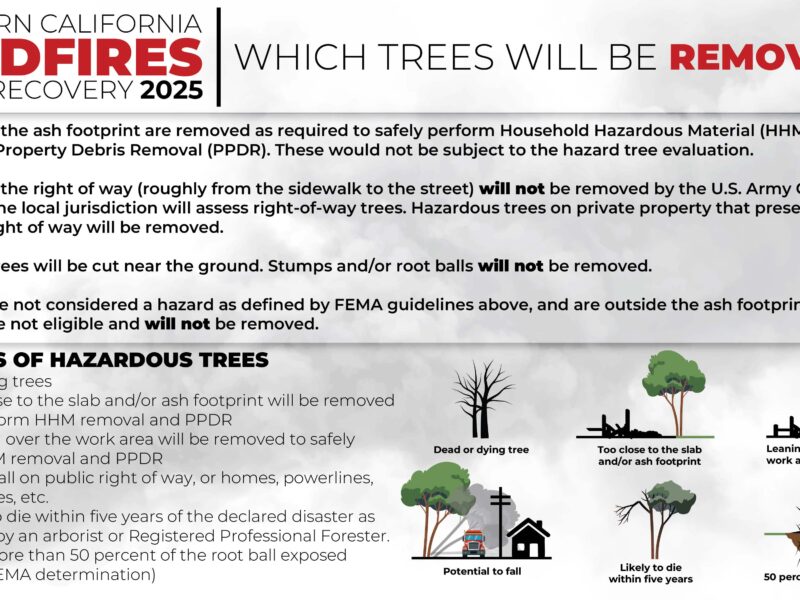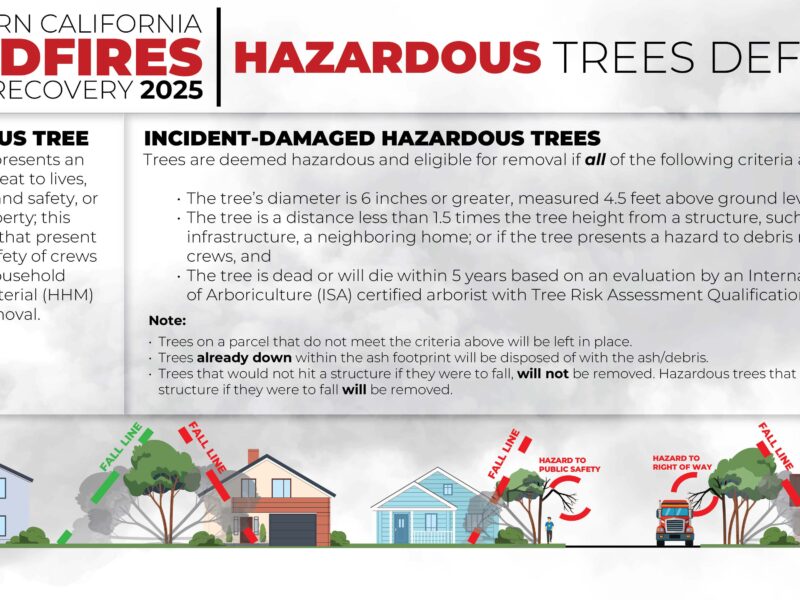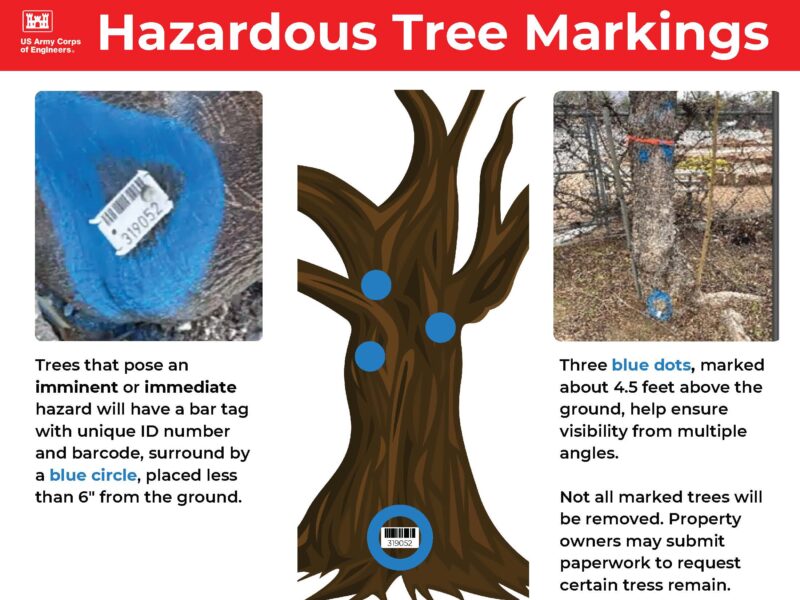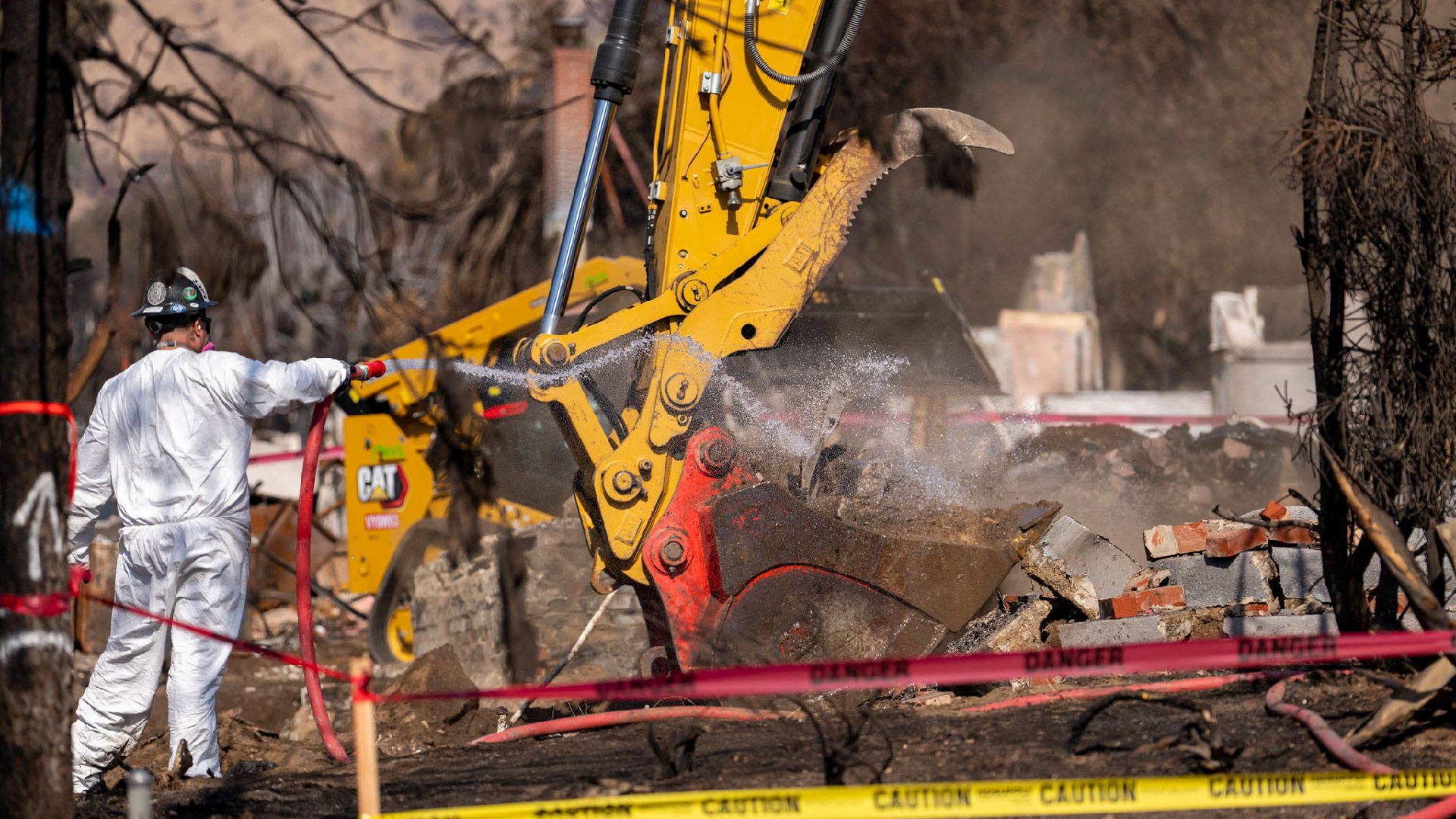
Phase 2: Debris Removal by US Army Corps of Engineers
Phase 2 of fire debris removal is being coordinated and managed by the US Army Corps of Engineers. A Right of Entry form is required if you want the U.S. Army Corps of Engineers to do work at no out-of-pocket cost to you. Those opting out should also submit the form to avoid delaying work in their communities.
The US Army Corps of Engineers has established a Debris Call Center to help answer questions regarding Private Property Debris Removal. Hours of operation are from 6:00 AM to 6:30 PM; call 213-308-8305 for assistance.
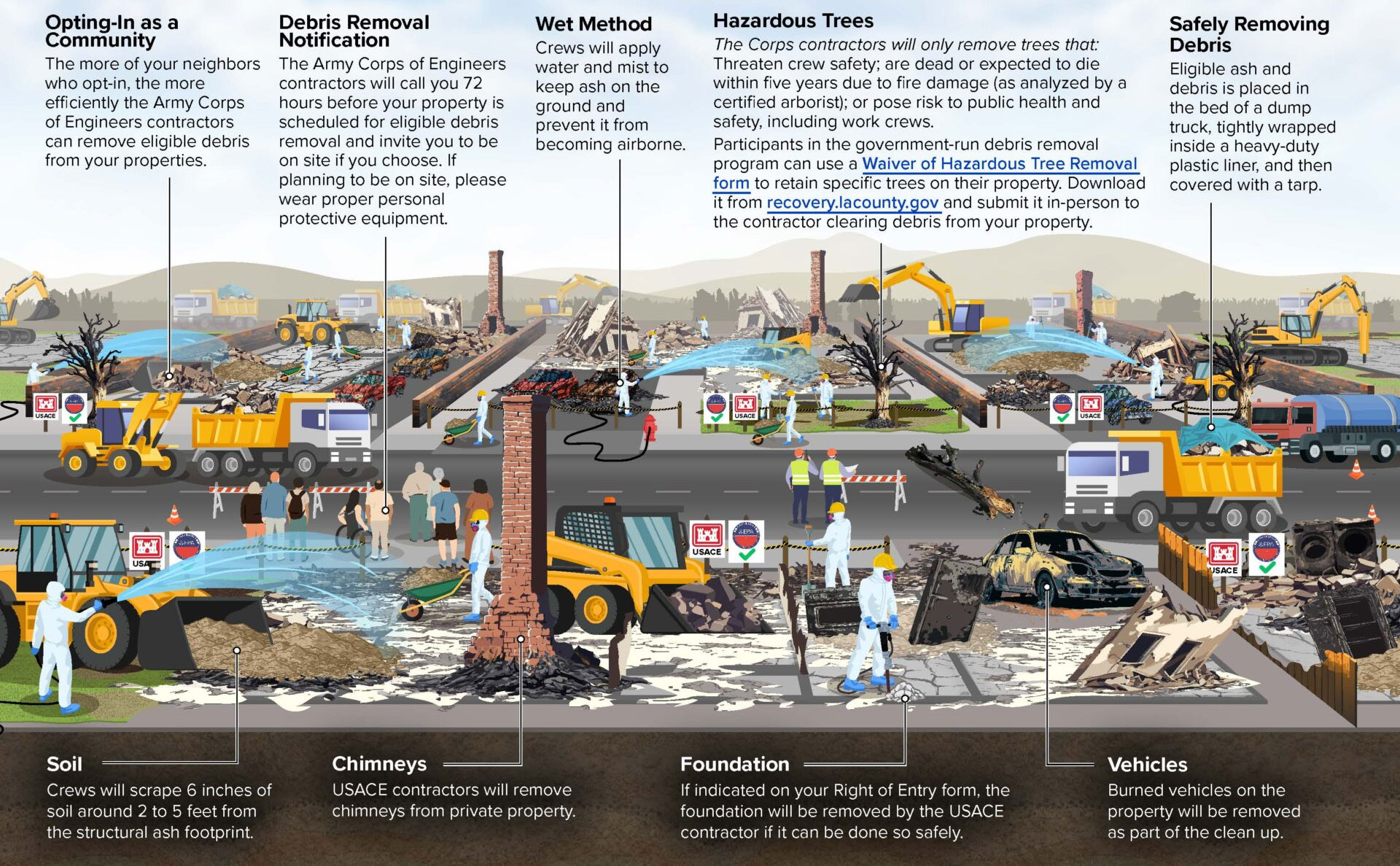
What to Expect When Phase 2 Debris Removal Gets Underway in Your Community
Clearing eligible ash and debris from your property is a key step on the road to recovery and eventually rebuilding. Here’s what residents who opt-in can expect to see on their property.
Learn MoreHazardous Tree Waiver
A hazardous tree removal waiver has been established for property owners participating in the federally funded Private Property Debris Removal (PPDR) Program who wish to retain specific trees on their property. This waiver allows owners to retain certain trees identified by an ISA-certified arborist to be hazardous. The waiver can be submitted via email or to the contractor during the 360-degree walkthrough, which is the last step before debris removal operations begin. Completed forms must be emailed to Eatoncallcenter@ecc.net for Altadena properties or Palisadescallcenter@ecc.net for Palisades properties.
A hazardous tree is any tree that poses an immediate threat to lives or public health and safety, including risks to debris removal crews. Under the PPDR Program, trees are eligible for removal if they meet all the following criteria:
- The tree has a diameter of 6 inches or greater (measured 4.5 feet above ground).
- The tree is a distance less than 1.5 times the tree height from a structure or presents a hazard to work crews.
Example: The tree could fall on a home or sidewalk. Refer to graphic for visual aid.
- The tree is dead or expected to die within five years as determined by an ISA-certified arborist with Tree Risk Assessment Qualification (TRAQ).
Additionally, trees that have fallen within the ash footprint will be removed as part of debris clearance efforts.
Property owners who wish to preserve specific hazardous trees must complete the Waiver of Hazardous Tree Removal form. Those opting out of hazardous tree removal should be aware that:
- Retaining hazardous trees may impact the ability to obtain a permit or rebuild on the property.
- The local permitting agency will determine rebuild requirements.
- The property owner assumes responsibility for future hazards caused by the trees they choose to keep.
Property owners interested in retaining a tree must:
- Complete the Waiver of Hazardous Tree Removal form.
- Provide a site sketch and list of trees they wish to preserve.
- Submit the completed form in person to the Corps of Engineers’ contractor during their site visit or email completed forms to Eatoncallcenter@ecc.net for Altadena properties or Palisadescallcenter@ecc.net for Palisades properties.
To obtain a copy of the waiver form, property owners can visit Waiver of Hazardous Tree Removal at recovery.lacounty.gov.
For media inquiries, contact the U.S. Army Corps of Engineers Wildfires Recovery Field Office Public Affairs at SoCalWildfires@usace.army.mil.
Frequently Asked Questions About Debris Removal by the US Army Corps of Engineers
Click here to download FAQ document
The U.S. Army Corps of Engineers is executing Phase 2 of the federally funded debris cleanup effort on behalf of FEMA. This is formally known as the Consolidated Debris Removal Program (also referred to as the Government-Sponsored Program). Their responsibility is to remove fire-related debris from private properties, including hazardous trees, ash and structural remains. On a property-by-property basis, this work will follow the EPA’s initial hazardous materials removal in Phase 1. However, the Army Corps of Engineers will not wait until all of the EPA work is done throughout the burn areas before stepping in to begin their Phase 2 work. Phase 1 and Phase 2 work will happen at the same time across both the Palisades Fire and Eaton Fire areas.
USACE prioritizes properties for debris removal based on several key factors to ensure public safety, environmental protection, and community recovery. These include:
- Parcels near ecologically sensitive areas
- Protecting watersheds, streams, and protected habitats from contamination is a top priority.
- Properties near rivers, creeks, and other sensitive ecosystems are prioritized to prevent erosion, sediment runoff, and water pollution.
- Reinhabited properties
- Areas where residents are actively living are prioritized to ensure unobstructed access, reduce health hazards, and minimize exposure to remaining debris.
- Neighborhood clusters are cleared more efficiently than isolated properties, helping restore a sense of community.
- Debris removal around hospitals, schools, emergency response facilities, and transportation corridors is prioritized to ensure continued access to essential services.
- Properties near critical infrastructure
- Areas near utility lines, water treatment plants, and power stations are prioritized to prevent disruptions and maintain essential functions.
Phase 2 involves removing visible fire debris, such as chimneys, hazardous trees, ash and, if specified on the right-of-entry (ROE) form by the owner, foundations. See the Army Corps of Engineers website for additional information on the debris-removal process and associated FAQs.
The Army Corps of Engineers will begin debris removal as the EPA completes its work in individual neighborhoods and a large number of residents complete right-of-entry (ROE) forms to opt in to have the Army Corps of Engineers clear their properties of debris.
Within the communities affected by fire, both phases of work will be going on concurrently. Working in two phases has proven to expedite the work of clearing property of debris in the wake of multiple fire disasters. The two agencies are not waiting for one phase to be completely finished across the region before the second phase begins.
On each individual property, the sequence goes in this order: EPA needs to first clear hazardous material in Phase 1 to expedite the larger debris removal work of the Army Corps of Engineers in Phase 2. The Army Corps of Engineers will follow behind EPA and clear Phase 2 debris as well as household hazardous material not removed by the EPA.
While specific timelines depend on factors such as site conditions, weather, and logistical constraints, USACE aims to remove debris as safely and quickly as possible, prioritizing the most critical areas first. Property owners will be informed 3-5 days before their property approaches the cleanup phase.
The Army Corps of Engineers crews are responsible for removing:
- Chimneys
- Hazardous trees (dead or at risk of dying within five years)
- Fire ash and debris
- Foundations (if specified in the ROE)
- Up to 6 inches of soil in the ash footprint (if necessary and safe to do so)
- Household hazardous materials not removed in Phase 1 by the EPA
Slope stabilizing structural walls and other foundational elements will not be removed if their removal could destabilize the property or neighboring areas.
Verified ROEs are grouped together and assigned to debris removal crews. Factors like property size, access, and the complexity of handling specific debris on site will determine how long each cleanup takes. See the Army Corps of Engineers website for more information on the debris-removal process and associated FAQs.
The Army Corps of Engineers is aiming for debris to be safely removed in two-to-three days PER PROPERTY. This timeline can change depending on the size of the lot or parcel, the amount of debris, inclement weather, and other factors, so it may take longer to remove debris. Other factors include the size of the lot, the amount of hardscape, the degree of damage, the condition of the foundation and whether you want to remove or try to maintain the foundation. None of those specifics will be available to the Army Corps of Engineers until they get on site. It will not be possible to estimate how long it will take to clean up your property until the contractor assesses the site. And for the same reasons, we cannot accurately predict at this time how long the overall cleanup effort will take.
Sign a right-of-entry (ROE) form giving the Army Corps of Engineers access to your property. The form can be found at recovery.lacounty.gov/debris-removal.
The deadline to opt into the government sponsored debris removal program is April 15, 2025. You should fill out the form as soon as possible, unless you are opting out of free debris removal by Army Corps of Engineers. Debris removal by the Army Corps of Engineers cannot proceed until you submit your form. Failing to submit the ROE form by April 15, 2025 is considered opting out.
No, the debris removal process is not a first-come, first-served process. There are a number of factors that determine when everyone’s lot will be scheduled for Phase 2 debris removal. To maximize efficiency, contractors schedule their work based on priorities set by the federal government with input from County. But getting your forms in early—and encouraging your neighbors to do so as well—will speed the work in your neighborhood.
If you have a destroyed structure on your property, please fill out and submit the form.
If you opt in, the debris removal will be performed for you by the Army Corps of Engineers, with no out-of-pocket cost. Your insurance payment for debris removal will be assigned to the government to help pay for the work; even if the insurance payment does not fully cover the work, the work will be performed at no charge to you. You do not need insurance to participate in the program.
If you opt out of the program, you must receive approval from the County and a permit from the applicable local city authority to proceed with debris removal. Then you will be responsible for hiring the appropriately licensed and certified contractors. You will be responsible for all costs of debris removal and asbestos abatement.
No, if no work has been done on your property by the Army Corps of Engineers, then the County will not ask for insurance proceeds. If you opted-in you must submit a Withdrawal form to formally opt-out of the program.
If you opt out of the program, once the EPA has completed its Phase 1 work, you will be responsible for hiring the appropriately licensed and certified contractors to remove the debris. This will include retaining a Certified Asbestos Consultant (CAC) to conduct a survey to identify asbestos in debris. If the CAC finds asbestos, you will need to hire an abatement contractor; and the CAC and abatement contractor will work together to submit an asbestos cleanup plan to South Coast AQMD for review and approval. More information on this process can be found here.
Your contractors will need to be approved by the County and your city, and you will be responsible for all costs of debris removal. The work must be completed in compliance with all local rules and regulations related to debris removal. Private contractors must also adhere to the same haul routes and safety standards being used by the Army Corps of Engineers to minimize neighborhood disruption. Please check in regularly for additional information and updates on specific regulations at recovery.lacounty.gov or call the LA County Public Works Fire Debris Hotline at 844-347-3332.
Yes, if you submit the ROE form and then decide to opt out, you can do so. However, it may cause delays.
Once your opt out application is approved, your permit issued, and any work is begun on your property, you cannot opt back in. You will bear the full cost of debris removal and disposal.
If you don’t have insurance, you can opt in to the Army Corps of Engineers debris removal program (Phase 2) at no out-of-pocket cost to you. If you opt out, you will be responsible for the cost of clearing the debris from your property.
Debris removal by the Army Corps of Engineers has no cost to you regardless of your insurance coverage or whether you have any insurance at all. If you do have insurance that covers this work, the government will ask your insurance company, not you, for reimbursement of costs up to the limits of that specific coverage.
Properties cannot begin Phase 2 until they have received a Phase 1 clearance from the USEPA. As ROEs are collected and ownership is verified, the Army Corps of Engineers will batch properties together for clearing with the objective of moving as quickly as possible and addressing health and safety issues as a top priority.
No, Phase 1 and Phase 2 will run concurrently. Once each cluster of properties is cleared under Phase 1, the Army Corps of Engineers can begin Phase 2 cleanup on properties where ROEs have been submitted, and ownership has been verified.
Generally, yes, but the recommendation is that each owner of a destroyed unit submit a ROE form as well as the HOA.
If the land under the trailer(s) is owned by an individual or entity beside the trailer owner, then the landowner must request removal.
The Army Corps of Engineers follows strict protocols for:
- Identifying hazardous trees and structures
- Using appropriate equipment and trained personnel
- Complying with environmental safety standards to prevent harm to workers, residents, and neighboring properties
The Army Corps of Engineers follows strict procedures to ensure public safety during private property debris removal. When removing fire ash and debris, the material is placed in the bed of a dump truck inside a heavy-duty plastic liner. This liner is tightly wrapped around the ash, and a tarp is then lowered over the truck to ensure the ash remains contained during transit. You will hear the Army Corps of Engineers teams call this process “burrito wrapping” because of the way the plastic is folded over itself to contain the debris.
The Army Corps of Engineers also utilizes the “wet method” for debris removal, which involves applying water and mist to keep ash on the ground and prevent it from becoming airborne. This approach helps mitigate risks to the community, particularly for standing homes that have been reoccupied.
A hazard tree is any tree in immediate danger of falling onto the crews that will be working to remove your debris or a public road. Hazard trees must be removed to protect the debris team and eliminate the immediate threat to the public at large. The debris management teams will remove trees that are a threat to the safety of the debris removal crews working on the property and trees that are dead or likely to die within five years as a result of the fire, as determined by a certified arborist, as well as those that present a threat to public health and safety public roadways or easements, and/or to public infrastructure, fire hydrants, water meters, etc.
You will need to indicate on the ROE whether you want your foundation removed. The Army Corps of Engineers will also remove chimneys. In-ground pools and driveways will not be removed.
Why removing fire-damaged concrete is essential to rebuilding safely:
In general, the structural integrity of concrete and masonry can adversely be affected in fire situations, especially when the structure is completely consumed by the fire. The properties of the material may be irreversibly altered deeming it unsatisfactory for reuse in supporting a rebuilt structure.
For property owners participating in the Government-Sponsored Program you have a choice to remove or keep foundations in place. Please contact your local building official for additional information about policies and procedures for the reuse of foundations in order to inform your decision. If you would like a structural assessment of your foundation you must work with your own private engineer to evaluate your foundation.
If the home is substantially damaged by the fire and requires demolition, FEMA will make the determination on eligibility. If the home is found to be eligible, the Army Corps of Engineers will demo and remove the fire debris.
If you opted-in to the Government-Sponsored Program for Phase 2, the operational crews will attempt to contact you 72 hours prior to starting debris removal work on your property. In the meantime, please ensure assessment and safety crews are able to access your property by unlocking gates and/or providing access codes to the EPA by calling (833) 798-7372 or, for Phase 2, that information can be provided to the Army Corps’ contractor when they contact you to schedule a site visit. You can also contact the Army Corps’ debris call center at (213) 308-8305.
Phase 2 cleanup is offered to eligible properties, as determined by FEMA. If a residence is standing and habitable, it likely will not be eligible. A destroyed structure of at least 120 square feet must be on the parcel in order to qualify for free debris removal by the Army Corps of Engineers. If you are unsure if you are eligible and wish to opt in to Phase 2, you are encouraged to complete the Right of Entry (ROE) form.
All upfront costs will be paid by government agencies. However, if property owners have homeowners, secondary, or automobile insurance covering debris removal, owners must inform the County by indicating that coverage on their ROE. The County has been assigned the responsibility to collect insurance proceeds. The County will work with insurance providers to ensure any proceeds specifically for debris removal are assigned to the government. Please note, Federal government agencies, such as FEMA, USEPA, and USACE, will NOT contact you to collect ANY payment related to the Government Sponsored Program.
No. This debris removal program is for fire-destroyed houses only, as identified by local, state or federal agencies.
Crews typically scrape 6” inches of soil around 2 to 5’ feet from the ash footprint.
Once the debris management teams have ensured that the cleanup meets the program standards, contractors will return to install erosion control methods. The debris management teams will then report to the County that the debris removal is complete. The County will then notify you that your property is safe and ready for rebuilding.
The safety of the general public and workers is a priority during debris operations. Yes, you may be present for Phase 2, but to reduce risks from safety hazards, the public is encouraged to stay away from areas where debris removal operations are underway. During Phase 1, the EPA has stated that if residents are home when they arrive, they will need to skip that property and return at a later date for your safety and theirs. Phase 1 may also have exclusion zones surrounding the current work area to ensure safety of the public.
The debris management teams will use erosion controls on the site as well as use silt collection devices around storm drains to minimize impacts to rivers, streams and aquifers. They are also taking measures such as wrapping the debris that is placed in trucks to minimize particles traveling from the air to the water.
The Debris Task Force’s safety professionals and contractor safety staff ensure work is complying with all OSHA, Cal/OSHA, CDC, and state and federal EPA standards.
Contractors are required to comply with all local, state and federal laws and regulations regarding safety and the environment. Whenever there is a conflict between codes or regulations, the most stringent regulation is applied.
Yes. However, to avoid a duplication of benefits provided by the government, the County will work with insurance providers to ensure any proceeds specifically designated for debris removal are assigned to the government.
For more information regarding insurance claims, coverage, or understanding your policy, please visit the California Department of Insurance website at:
http://www.insurance.ca.gov/01-consumers/140-catastrophes/WildfireResources.cfm or call the Insurance Consumer Hotline at (800) 927-4357.
It depends on the policy that you have. There are generally two types of debris removal coverage in a homeowners insurance policy:
- Specified Amount: If your homeowners insurance policy contains a separate, debris-specific clause, the County will only seek the specified amount designated in the debris removal clause. These clauses are typically capped at a percentage of the coverage amounts listed in the policy (for example, 5 percent of the value of a primary structure, other structure, and personal property). You will not owe the County any additional money, even if the actual costs to remove the debris exceeded the amount designated in your insurance policy for debris removal.
- No Specified Amount: If your homeowners insurance policy does not have a separate, debris-specific clause and instead includes the costs of debris removal in the total coverage, the County will only collect insurance proceeds for debris removal after you have rebuilt your home. The County will only collect any available insurance proceeds, if any, after the rebuild. If there are no remaining funds, the homeowner will not owe the County any additional money for debris removal.
No. The County will only work with insurance carriers to seek debris removal specific assignments as stated above. The County will not attempt to collect any insurance proceeds designated for other uses such as rebuilding.
Yes. If you have a specified amount for debris removal in your insurance policy, you may use your insurance proceeds to remove fire related debris that is ineligible for removal under the program (for example, swimming pools, patios, trees, etc.). The County will only collect remaining insurance proceeds, if any, after you have removed fire-related debris not included as part of the Government Sponsored Program.
If your homeowner’s insurance policy does not have a separate, debris-specific clause and instead includes the costs of debris removal in the total coverage, you may use these proceeds to pay for the removal of fire-related debris that is not included as part of the Government-Sponsored Program. The County will only collect remaining insurance proceeds, if any, after your residence is rebuilt.
In either scenario, the property owner will be required to substantiate all expenditures.
For more information regarding insurance claims, coverage, or understanding your policy, please visit the California Department of Insurance website at http://www.insurance.ca.gov/01-consumers/140-catastrophes/WildfireResources.cfm or call the Insurance Consumer Hotline at (800) 927-4357.
Property owners are advised not to begin clearing remaining ineligible debris until Phase 2 has been completed on their property as this may affect eligibility to participate in the program.
If property owners of a structure destroyed by the fire choose to opt-in to the Government Sponsored Program, then burned vehicles on the property will be removed as part of the clean-up. If burned vehicles on private property are not covered or blocked by structural fire debris, property owners can work directly with their insurance company to have the vehicle towed from their property prior to Phase 2 debris removal.
The Army Corps of Engineers advises that pool water may be pumped out of swimming pools for wetting the debris which is used to keep dust down during the debris removal process. Any fire debris in the pool will be removed by the contractor. Contractor will place metal fencing completely around the pool where feasible and notify the homeowner. This only pertains to pools adjacent to structures that are considered within the ash footprint.
Please see Los Angeles County Public Health’s guidelines for Swimming Pools Impacted by Fire, Smoke, and Ash: http://www.publichealth.lacounty.gov/eh//docs/safety/swimming-pools-after-fire.pdf
For more information, please contact the Environmental Health, Recreational Waters Program at (626) 430-5360 or rhealth@ph.lacounty.gov.

